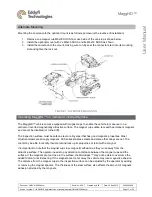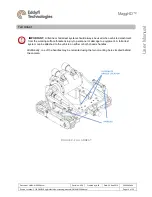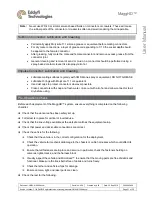
MaggHD™
Document: UMAU015088.docm
Revision: A08
Created by: KJB
Date: 26 Sep 2019
3080885-A08
Source Location: C:\ePDM\ISLEng\products\au-micromag\manuals\UMAU015088.docm
Page 12 of 29
User Ma
nual
System Power
Power Requirements
The
MaggHD™ is operated through an ICON™ Portable Controller, or a Rackmount Interface Box. These
controllers provide power to the tether and vehicle.
Refer to the Controller User Manual for further details and power requirements.
Generators / Inverters
If powering t
he system from a generator or inverter, refer to that unit’s operating manual for
recommendations on continuous and peak load ratings. These power sources may apply a reduced
output rating based on electrical load and environmental temperature. Remember to include the power
needs of all other connected devices (external monitors, recording devices, lighting, etc.) when selecting
a generator or inverter.
Galvanic Corrosion Control
We strongly recommend cathodic protection whenever the vehicle is being deployed in a salt water
environment, either submerged or in salt spray. We recommend
aluminum
marine anodes exclusively for
use with the inspection system. Aluminum anodes are common in the marine industry and are replacing
zinc anodes in many areas. For inspection systems that are often pulled in and out of salt water,
aluminum anodes are especially important, as zinc anodes tend to scale over when exposed to air and
may not reactivate when submerged again. An aluminum anode will always reactivate.
For permanent installations, it is required that the structure to which the system is mounted also be
protected by
aluminum
anodes. If the structure is of a dissimilar metal, the system mount must be
isolated from the structure. Do not mix anode types (zinc and aluminum) on the assembly. There must be
only one anode type throughout the structure. Avoid use of Magnesium anodes altogether.
System Setup
Personnel Requirements
Basic deployment of the MaggHD
™ system may be performed by one person. Operations at more
complex worksites may require two people, especially when the console location is removed from the
point of deployment.
•
Console Operator:
This person is responsible for driving the vehicle, watching the location of the
inspection and making comments about it and the surrounding conditions. It is also the operator’s
responsibility to assess whether the location of the inspection is in the appropriate condition for
safe passage of the vehicle or if there is a risk of getting stuck. The operator may also assist in
general site setup (cones, warning signs, etc.), vehicle maintenance and configuration.
•
Deployment / Tether Handler / Field Maintenance:
This person has several tasks including:













































